NVIDIA Announces the GeForce RTX 20 Series: RTX 2080 Ti & 2080 on Sept. 20th, RTX 2070 in October
by Ryan Smith on August 20, 2018 4:00 PM ESTGeForce RTX 2080
Moving down the stack, we have the GeForce RTX 2080. Normally the king of an NVIDIA launch product stack, this cycle’s x80 card is instead playing second-seat to the RTX 2080 Ti. However in terms of pricing and the general market position, it remains in a similar position.
| NVIDIA GeForce x80 Specification Comparison | ||||||
| RTX 2080 Founder's Edition |
RTX 2080 | GTX 1080 | GTX 980 | |||
| CUDA Cores | 2944 | 2944 | 2560 | 2048 | ||
| ROPs | 64? | 64? | 64 | 64 | ||
| Core Clock | 1515MHz | 1515MHz | 1607MHz | 1126MHz | ||
| Boost Clock | 1800MHz | 1710MHz | 1733MHz | 1216MHz | ||
| Memory Clock | 14Gbps GDDR6 | 14Gbps GDDR6 | 10Gbps GDDR5X | 7Gbps GDDR5 | ||
| Memory Bus Width | 256-bit | 256-bit | 256-bit | 256-bit | ||
| VRAM | 8GB | 8GB | 8GB | 4GB | ||
| Single Precision Perf. | 10.6 TFLOPs | 10.1 TFLOPs | 8.9 TFLOPs | 5.0 TFLOPs | ||
| "RTX-OPS" | 60T | 60T | N/A | N/A | ||
| TDP | 225W | 215W | 180W | 165W | ||
| GPU | Unknown Turing | Unknown Turing | GP104 | GM204 | ||
| Architecture | Turing | Turing | Pascal | Maxwell | ||
| Manufacturing Process | TSMC 12nm "FFN" | TSMC 12nm "FFN" | TSMC 16nm | TSMC 28nm | ||
| Launch Date | 09/20/2018 | 09/20/2018 | 05/27/2016 | 09/18/2014 | ||
| Launch Price | $799 | $699 | MSRP: $599 Founders $699 |
$549 | ||
NVIDIA has not disclosed anything about the GPU used here. As I highly doubt it’s using Big Turing, I expect we’re looking at the next Turing down, which would presumably be TU104. And although we don’t have die size or transistor counts, in terms of functionality it appears to be a straight smaller version of Big Turing, featuring a proportional number of CUDA, tensor, and RT cores.
Altogether we’re looking at 2944 CUDA cores paired with what should be 368 tensor cores. I expect that like the RTX 2080 Ti, for the RTX 2080 what we’re looking at is not a fully-enabled TR104 part, especially as the similar Quadro RTX 5000 has slightly better specifications. Also like the RTX 1080 Ti, clockspeeds have dropped a bit from generation to generation, as the base clock is down to 1515MHz and the boost clock to 1710MHz. All told we’re looking at a pure CUDA core compute throughput of 10.1 TFLOPs, about 13% higher than the GTX 1080. Or if we compare it to the RTX 2080 Ti, we’d see around 75% of the expected compute/tensor performance, which is only a bit larger than the jump we saw between the GTX 1080 and GTX 1080 Ti.
Meanwhile it’s clear that the card will come with a fully enabled memory bus, meaning we’re looking at 8GB of GDDR6 running at 14Gbps, on top of a 256-bit memory bus. Relative to the GTX 1080 this is an even more significant 40% increase in memory bandwidth.
As for TDPs, they’ve gone up for this band of cards. The stock RTX 2080 will have a 215W TDP, up 30W from the GTX 1080’s 180W TDP, and an even bigger increase if we look at GTX 980’s 165W TDP. It’s no secret that NVIDIA is fighting a losing battle with Moore’s Law here, and barring massive efficiency improvements, there is a need to increase TDPs to keep up overall performance. TU104 is undoubtedly also a big chip, and without a full node shrink, it would seem that NVIDIA has to pay a power penalty instead. In the meantime this higher TDP also negates some of the RTX 2080 Ti’s power disadvantage, as now that gap is just 35W instead of 65W.
Past that, NVIDIA is offering an overclocked Founders Edition card here as they are with the RTX 2080 Ti. The RTX 2080 Founders Edition will ship with an 1800MHz boost clock (up 5%), and the TDP will be 10W higher at 225W.
Power delivery for the 2080 FE and similar reference cards will be a 6pin + 8pin configuration, which on paper is good for 300W. NVIDIA's official PCB photo for the card shows a similar VRM configuration as the 2080 Ti, so that means we're looking at what appears to be 10 phases driving the GPU among 13 phases in total. NVIDIA has also disclosed that the RTX 2080 Founders Edition in particular has an overclocking power limit of 280W, confirming earlier claims about being more overclocking-friendly than past reference designs.
The Founders Edition card will also retain the same dual fan reference cooling design as its bigger sibling, right down to its 10.5-inch long physical dimensions. This also includes the card-length vapor chamber that's used on the RTX 2080 Ti as well. So the only difference between the two cards, other than the power connectors, will be on the inside. Which also means that NVIDIA’s 2080 reference PCB will use the same 3x DisplayPort + 1x HDMI + 1x USB Type-C configuration as the other card.
Finally, in terms of pricing, the RTX 2080 will also be seeing a price hike over the last generation. Though not as significantly as the RTX 2080 Ti. The MSRP for a stock card will be $699, $100 over the launch price of the GTX 1080 and $200 over its current list price. Meanwhile the Founders Edition card will carry a further $100 premium, pushing it to $799. Finally, like the RTX 2080 Ti, the 2080 will be shipping in the first wave of cards on September 20th.
GeForce RTX 2070
The final member of the new GeForce RTX family is the GeForce RTX 2070. Traditional for its roots, this is the “value” enthusiast card, giving up some of the RTX 2080’s performance in exchange for a lower price. Though with prices starting at $499, “value” and “cheap” are not the same thing.
| NVIDIA GeForce x70 Specification Comparison | ||||||
| RTX 2070 Founder's Edition |
RTX 2070 | GTX 1070 | GTX 970 | |||
| CUDA Cores | 2304 | 2304 | 1920 | 1664 | ||
| ROPs | 64? | 64? | 64 | 64 | ||
| Core Clock | 1410MHz | 1410MHz | 1506MHz | 1050MHz | ||
| Boost Clock | 1710MHz | 1620MHz | 1683MHz | 1178MHz | ||
| Memory Clock | 14Gbps GDDR6 | 14Gbps GDDR6 | 8Gbps GDDR5 | 7Gbps GDDR5 | ||
| Memory Bus Width | 256-bit | 256-bit | 256-bit | 256-bit | ||
| VRAM | 8GB | 8GB | 8GB | 4GB | ||
| Single Precision Perf. | 7.9 TFLOPs | 7.5 TFLOPs | 6.5 TFLOPs | 3.9 TFLOPs | ||
| "RTX-OPS" | 45T | 45T | N/A | N/A | ||
| TDP | 185W | 175W | 150W | 145W | ||
| GPU | Unknown Turing | Unknown Turing | GP104 | GM204 | ||
| Architecture | Turing | Turing | Pascal | Maxwell | ||
| Manufacturing Process | TSMC 12nm "FFN" | TSMC 12nm "FFN" | TSMC 16nm | TSMC 28nm | ||
| Launch Date | 09/20/2018 | 09/20/2018 | 06/10/2016 | 09/18/2014 | ||
| Launch Price | $599 | $499 | MSRP: $379 Founders $449 |
$329 | ||
Like the 2080, we don’t know the specific GPU being used here. But it’s almost certainly a somewhat significantly cut-down TU104. NVIDIA has shaved off several SMs here, resulting in 2304 CUDA cores and what should be 288 tensor cores. Meanwhile ray tracing performance is rated at 6 GigaRays/second.
Like the other RTX cards, clockspeeds have dropped a bit versus the previous generation; the base clock now starts at 1410MHz, and the boost clock is 1620MHz. On paper then, compute throughput works out to 7.5 TFLOPs, up 15% from GTX 1070. Or if we compare it to the 2080, the 2070 should deliver around 75% of its bigger sibling’s compute performance, which makes the jumps between the 2070, 2080, and 2080 Ti all very symmetrical. This is also an ever so slightly smaller gap than what was between the GTX 1080 and GTX 1070.
Also like the RTX 2080, this appears to be a fully enabled memory configuration. Meaning we’re looking at 8GB of GDDR6 running at 14Gbps, on top of a 256-bit memory bus. Relative to the GTX 1070 this is the single greatest bandwidth increase of all of the RTX cards; the 2070 will enjoy a 75% increase in memory bandwidth over its Pascal predecessor, as the GTX 1070 never did use GDDR5X.
TDPs have gone up here as well. The RTX 2070 is rated for 175W, up from 150W for the GTX 1070, and 145W for the GTX 970. As with the RTX 2080, it looks like NVIDIA is paying for their performance and new features via higher power consumption in lieu of a full node shrink.
Past that, NVIDIA is offering an overclocked Founders Edition card here as well. The RTX 2070 Founders Edition will ship with a 1710MHz boost clock (up 6%), and the TDP will be 10W higher at 185W.
Power delivery for the 2080 FE and similar reference cards will be a single 8pin connector, which on paper is good for 225W. Notably, thanks in part to cutting out a power connector, this card is shorter than the RTX 2080 – as is often the case for x70 cards – and comes in at just 9-inches long. Consequently, while the Founders Edition card retains the same basic industrial design as the other RTX cards, it’s not going to be the same exact shroud, owing to the shorter size and lack of an NVLink connector.
Otherwise in terms of display outputs, NVIDIA’s reference PCB is the same as the other cards: 3x DisplayPort + 1x HDMI + 1x USB Type-C.
Finally, in terms of pricing, like all the other RTX cards, the RTX 2070 will be seeing a price hike over the last generation. The MSRP for a stock card will be $499, $120 over the launch price of the GTX 1070 and around $100 over its current list price. Meanwhile the Founders Edition card will carry a further $100 premium, pushing it to $599.
However unlike the top two cards, the RTX 2070 will not be shipping on September 20th. While NVIDIA has announced the card, both their Founders Edition card as well as partner cards will not be shipping until some point in October. Consequently, pre-orders are not available at this time. Which coincidentally brings us to our final point…
Pre-Orders Starting Now
As mentioned in the introduction to this article, NVIDIA and its board partners are already taking pre-orders on the new GeForce RTX cards. As a general piece of advice, we caution against pre-ordering new hardware until it can be properly reviewed by a reputable third party (i.e. us). However in the case of the GeForce RTX series I feel that this is especially important, as NVIDIA has provided no meaningful guidance when it comes to performance expectations. So we don’t even know how well these cards will perform relative to their Pascal predecessors on current-generation games.
None the less, unless NVIDIA is sitting on a massive launch inventory, I have to admit that I have trouble believing that retailers will remain in stock ahead of the September 20th launch. Launch-day sell-outs have become common for video cards, and even with the unfortunate use of pre-orders here, it wouldn’t be surprising to see pre-orders run out before we reach the 20th. So potential buyers will have some hard choices to make if they want to ensure they have a card on launch day.
Meanwhile as far as pricing is concerned, while NVIDIA does have their $999/$699/$499 baseline MSRPs, the reality is that you won’t be able to find cards at these prices. And likely won’t be able to for weeks or months. The launch-day sell-out phenomena means that board partners have prioritized higher-end card designs, with pricing to match. As of this afternoon, I have not seen an RTX 2080 card listed below $749, and most are at or over the $799 price tag of the Founders Edition card. The gap is even bigger for RTX 2080 Ti cards, where I haven’t seen any for less than $1150. So there’s certainly merit to any arguments that at least for the launch, prices are closer to $1150 and $750 respectively.
None the less, if you are looking to pre-order a card, Newegg, Amazon, and NVIDIA are all taking pre-orders while they last. So at the very least there is a reasonable choice of retailers to choose from. We have not had a chance to dig into any of the board partners’ cards yet, but it would appear that this is going to be a semi-custom launch: that is, everyone is shipping a card using NVIDIA’s reference PCB and then their own custom cooler on top of it. So cooling aside, all of the launch-day cards should offer similar features.


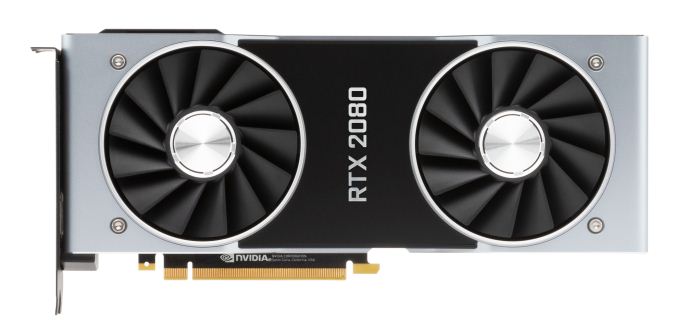
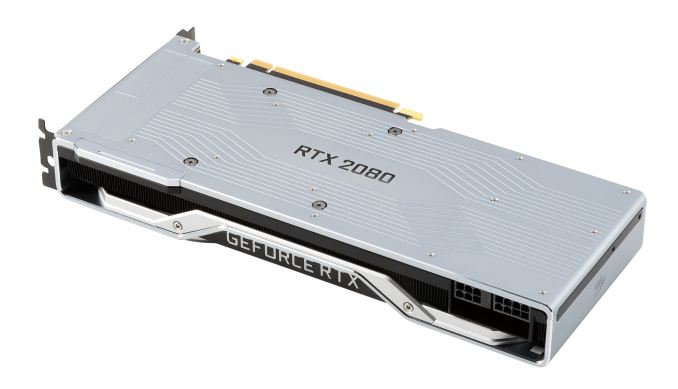
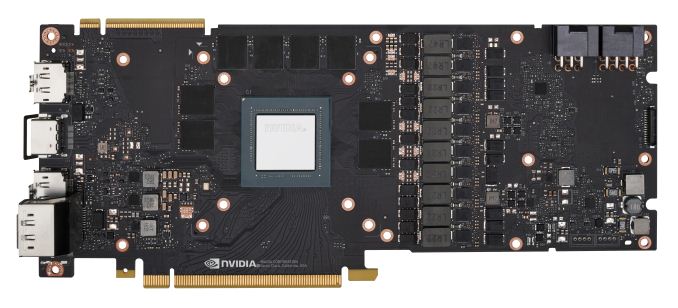
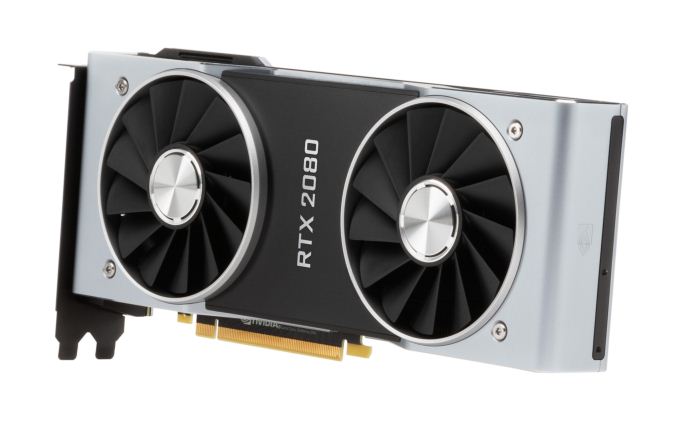
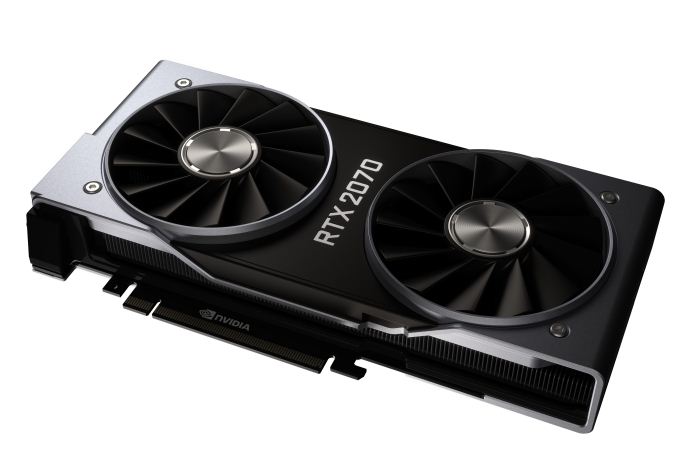
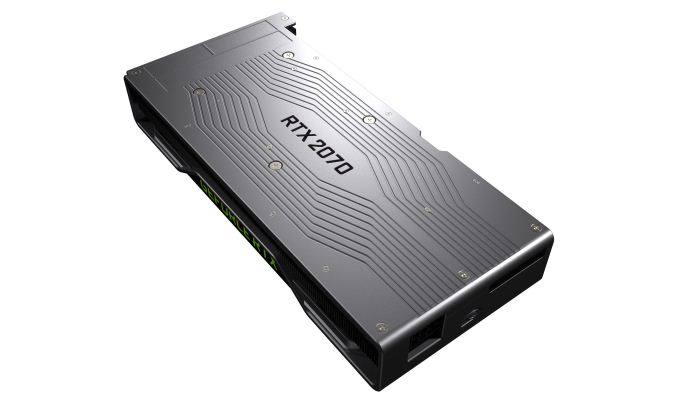
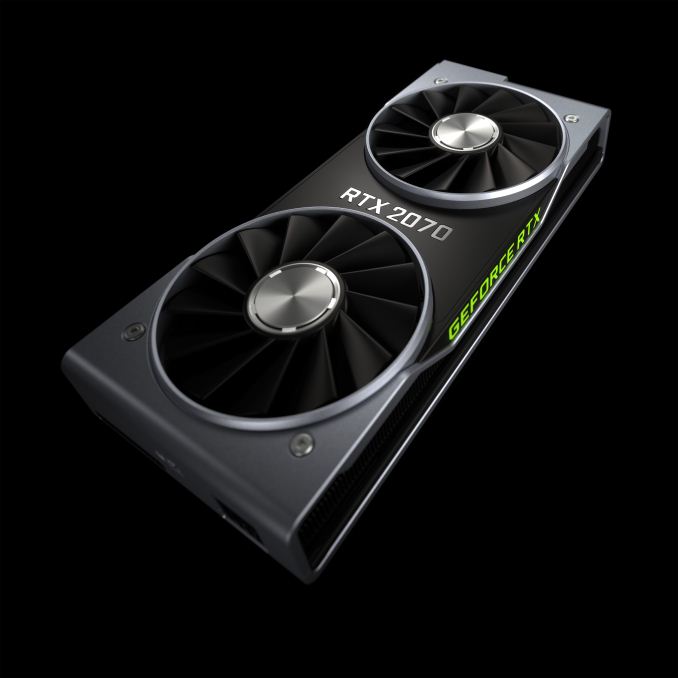








223 Comments
View All Comments
GraXXoR - Tuesday, August 21, 2018 - link
It's Nvidia's blind-prepurchase payment that is really pissing me off. As long as fanboiz are willing to empty their wallets of $1k before a single review has even been written means that this sort of prepayment will start even earlier next year...... and before you know it, we'll be pledging for "perks" for the next generation of GPUs instead of purchasing.
HammerStrike - Monday, August 20, 2018 - link
Pricing issues aside (although, IMO I'm not to shocked or put out by the prices, obviously lower is better but I'm not angry or losing sleep) I'm surprised that there is less enthusiasm on the forums for the first GPU to highlight real time ray tracing as a fully supported feature set designed to be used in game at playable frame rates. That's pretty revolutionary. Ever since I started following PC graphics (dual VooDoo2 SLI 8MB's were my first GPU's, still remember them fondly) real time ray tracing was considered the holy grail of rendering - the mile stone that was always talked about as "you'll know we've arrived at nirvana when it comes."We'll, it's here! And, for all the talk about Nvidia's next gen of cards over the last 6 months, with the exception of the week since the Quadro announcement at SIGGRAPH, it's been kept pretty much under wraps. As of a month ago I would not have guessed that the new gen of cards would have such a focus on ray tracing, so the news is somewhat surprising and, from a pure techno-nerd stand point I think it's awesome! Not saying that as a Nvidia fanboy (I've owned many cards from many different OEM's over the years), but just as an avid gamer and technology enthusiast this is a pretty seminal moment. Regardless of the price point it's at today, this tech is going to filter out into all of Nvidia's (and presumably AMD's) product stack over the next 1-2 years, and that's extremely exciting news! Assuming AMD has been active with MS in developing DXR, their next gen of GPU should be supporting ray tracing as well, which means there is a decent chance that a DXR/ray tracing feature set is included in the next gen of consoles due in the next couple of years. This is really ground breaking tech - 6 months ago the common wisdom was that "real time ray tracing" was still years away, yet it's launching Sept 20th.
Granted, it's a hybrid approach, but given the 20+ year investment in rasterization 3D modeling, and the fact that every game currently released and in development is designed for a rasterized pipeline, it's not surprising, and frankly that's probably the smartest way to deploy it - rasterization has many good qualities to it, and if you can improve once if it's biggest weaknesses (lighting) through a hybrid approach with ray tracing that is the best of both worlds.
Anyway, I'm rambling. From a long time gamer I'm very excited to see some reviews of these cards and how dev's integrate ray tracing into their engines. Great time to be a gamer! Great job Nvidia! Say what you will about the price of the cards, that's a (relatively) short term phenomenon, while the direction this is pushing the industry in will be felt over the next decade, if not beyond.
schen8 - Monday, August 20, 2018 - link
Very well said HammerStrike!I'm and old school gamer too, grew up on the Voodoo 2 SLIs w/ Riva 128.
Those were the days! Nvidia's keynote today really hit it right out of the park!
It is propelling us into the next decade of gaming graphics. I'm truly excited and can't wait to pick up a new card!
gerz1219 - Monday, August 20, 2018 - link
I think you’re not seeing more enthusiasm for real-time ray-tracing because we won’t see any AAA titles that take advantage of it until the average GPU supports it. And that’s not going to happen when the price point is $1200. It’s not going to happen until there are new Xbox and PlayStation consoles that have ray-tracing capabilities. And by the time that happens the 20** series will be obsolete. It’s exciting that they’re going in this direction, but these cards will never actually take us there.Dug - Monday, August 20, 2018 - link
You didn't watch the video, did you?wyatterp - Tuesday, August 21, 2018 - link
They literally showed 20+ games upcoming, to include 2 near term triple A launches (granted it's unknown if those games will support RTX at launch). BFV and Tomb Raider looked insanely good.eva02langley - Tuesday, August 21, 2018 - link
That they paid to get their support. It is all about the perception, but this is nothing more than Physix 2.0.Nobody developing their games on console are going to bother because AMD is the sole GPU provider.
The money is not worth it for maybe 4% of the PC market purchasing these cards.
wyatterp - Tuesday, August 21, 2018 - link
I'm with you - reading these comments is depressing. Gamers and tech lovers are some salty people of late - a jaded, skeptical lot here at AT! I know it's fair to be somewhat reserved, but the IQ increase of Ray Tracing looked more than a gimmick - it fundamentally changes how real time games looked, at least by demos. I know most people here want it, they are just pissed they can't afford it, so they want to dump on the capability here to justify their anger. I get it.I decided to preorder the 2080. I'm all in on this...assuming increased performance over the 1080 for "old rendered" games (from 8 to 10 TFlops?) - and hopefully it can run BFV at 60 FPS with RTX on. I know I'll be buying 3 of the RTX enabled games anyways. The way lighting and shadow worked in Shadow of Tomb Raider was impressive. BFV looked like offline renders.
bogda - Tuesday, August 21, 2018 - link
You cannot put pricing aside. In order to get useful raytracing performance 1080p one will need 2080 Ti. From that I can conclude that RTX 2070 and 2080 will not be powefull enough to run realtime raytracing in games.I think for gamer spending 1200$ just to get realistic reflections and shadows is ridiculous.
BTW there was no mention of VR in keynote. What VR neededed was more rendering power for less money so these cards probably sound end of VR on PC.
HammerStrike - Tuesday, August 21, 2018 - link
1. I never said don't take pricing as a point of data, I just said there is a LOT more about the RTX series announcement then just the price, which is what the majority of comments seemed focused on. Real time ray tracing is the holy grail of rendering - the fact that it's showing up in any form in 2018 is pretty exciting.2. Where are you getting your info that you'll need a 2080 ti to run "useful" frames at 1080p with RT enabled? While I agree that we should all reserve a BUYING decision until trusted reviews are out there, this is just pure conjuncture that is apparently driven by your disappointment / saltiness / anger over the price of the cards.
3. We could argue that RT, even as it's implemented in the RTX series, is a lot more then just "realistic shadows", but that's besides the point. Regardless of what aspects of the image quality are improved, that's the whole reason to upgrade a GPU right now. If image quality is of minor or no importance, you can drop your IQ settings to low and get 60+ FPS on a GTX 1050TI right now for $150. I get confused with all this "it's not useful, it just makes the image quality better" line of argument. People weren't drooling over the Cyberpunk 2077 demo at E3 because it was running at a super high frame rate.
3. While I don't disagree with your point on VR, I wasn't really debating that. However, there still is the question of what Nvidia will position for their cards that cost less then $500. Regardless of what they are pricing the 2070+ cards at, my (semi) educated guess is that 95%+ of GPU's sold are sub $500. I'd bet that 80%+ are less then $300. While we can talk about "market" pricing, and whether Nvidia is good or evil for pricing these cards where they did, it doesn't change the fact that the mainstream of the market is at $300 or less, and no amount of halo product / pricing is going to change that. Say what you will of Nvidia, they are not stupid, and I'd be surprised if they didn't refresh their product stack in that price range, and I'd be equally surprised if they didn't provide a meaningful performance boast in comparable price tiers.
It's also worth noting that the die's on the RTX series are FREAKING HUGE. Lots of consternation of "price inflation" based on model series from 7 gen to 9th to 10th to 20th, but end of the day those are just names. The primary driver of the cost of production in any semiconductor is the size of the die. The 2080ti has a die Size of ~757mm^2, where the 1080ti has a 471mm^2 die. That's basically a 60% increase in die size. Even assuming the yields are the same, they still use 300mm wafers, and the cost of manufacturing is per wafer, so everything else being equal their productions costs went up by 60%. DRAM prices are all higher then they were 2 years ago. If you take the $700 price of the 1080ti at launch, add an additional 60% to it and throw in $30-$50 more in GDDR pricing and you have a card in the $1200 range.
Not saying that makes the pricing "ok" but simply to suggest that there no reason other then "greed" (I know you didn't make that specific argument, but it's pretty common on the forums) is pretty short sighted.
This is a freakin' monster chip with revolutionary tech that is enabling for the first time the holy grail of rendering tech, real time ray tracing. Whether or not blowing out the silicon die area to support that, and charging the prices they are that are necessitated by that, turn out to be a good business decision remains to be seen. But from a pure tech standpoint it's pretty awesome. It't would be like Ford announcing a Mustang with a 1500 HP engine in it that costs $150K. Maybe there is enough of a market there, maybe there isn't, but I'm not going to get so hung up on the price to not appreciate the pure ridiculousness of what they made. Same here.